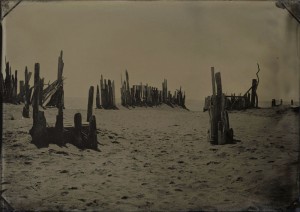My photographs have embraced the traditions of landscape, seascape, and architecture. The human imprint on these views is what concerns me. I search out relics and ruins reflecting that imprint to reference the past and our history. Working with a large format wet-plate camera, I scout locations that are close to or directly on the water. It is at the edge of the land and sea that the mystery of an abandoned past is revealed. Structures that have long ago lost their functionality are now emblematic of a more primitive and lost time. These views/photos represent the last stand, the human effort as can be most poignantly seen through decay and the return to nature. Illuminating this fragile place, I intend to draw attention to these sites and their contradictory nature.
The wet-plate collodion process, widely used in 1860’s, has a profound relevance to this body of work. Ironically this process frequently documented the dawn of the industrial revolution and its locations. To employ it now creates a visual thread. I use period lenses and original chemical formulas to reference this history. I also maintain a very spare and contemporary aesthetic to differentiate my work from what has come before me. I have mixed up the standards that my forefathers have used as well. I shoot landscapes with portrait lenses and prefer lenses that don’t completely cover the size glass I have chosen, giving my pictures a vignetted effect. All of these choices are meant to show the viewer a little more of the craft than is customarily expected. The hand poured collodion process produces unique and instantaneous positives on a glass plate (ambrotypes) or tin (ferrotypes) as well as negatives. The entire process is done on location, with a portable darkroom.

